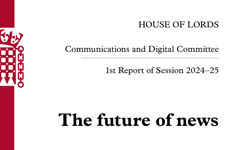
Newspapers used to carry the slogan ‘At The Heart Of All Things Local’ under their titlepiece. It wasn’t an empty boast. When I started at the Shields Weekly News in Tyneside, there were a dozen journalists and two photographers serving around 30,000 people. I sat all day in the magistrates court, covering every case in detail. We went to every inquest, every council meeting and walked to the quayside to get the fish prices and, as the news-editor put it, find ‘some bloody good stories’.
I now live in the South and my weekly covers little of that. I am sometimes asked if the paper ‘is still going’. I assure them it is and that they should buy it. One neighbour told me the local Facebook group is all she needs … road closures, accidents, missing dogs, suspicious characters, church hall events, power cuts and she had just sold an old dresser on there.
So I asked senior players for a candid assessment of whether traditional papers can still claim to be ‘at the heart of all things local’. One told me we should accept that most weeklies are no longer viable, close them and channel the resources elsewhere. There isn’t the appetite for local weekly newspapers any more and the revenue isn’t there. Brutal.
Gary Shipton, deputy editor-in-chief of JPIMedia, disagrees. He oversees the group’s Sussex weeklies which he says enjoyed their best newspaper sales trends in a decade in 2021 - with the Crawley Observer, Chichester Observer and West Sussex Gazette showing strong year-on-year performance “and no bulks”. Digitally, they are committed to town by town news overlayed with county information.
Indeed, most I spoke to were confident local journalism can thrive.
David Bourn, former editorial director of weekly papers in Scotland and now print editor at The Northern Echo, says: “I have actually never felt this optimistic about the future of our industry for a long time. It feels like there has been a significant change - people are hiring and innovating and titles are being launched. We are now starting to understand digital publishing and its relationship with print much better.”
Tim Robinson, managing editor at JPIMedia, insists the local news industry is “changed rather than broken”.
He says: “Comparing what we did 20 years ago is a redundant measurement. It is about growing a local audience each day, growth that maintains quality, and we are doing that.” It hasn’t been feasible, for years, to offer the blanket coverage of old but with analytics and social media, we can give people what they want. People stories and nostalgia are high on the list and trust is the key, he says.
That point is reinforced by Gary Shipton: “Local papers are often the only source of professionally trained journalists committed to the community. There is little benefit in using those reporters to rewrite press releases and contributed material. They need to focus on unique, quality content that people cannot get elsewhere. Our journalists have areas of expertise and interests, so liberating them to share that knowledge is equally important. Digital means that, unlike traditional local newspapers that would only be read in the circulation areas, a great story can go global.”
So what do they think the industry must do to remain ‘at the heart of all things local’?
I have actually never felt this optimistic about the future of our industry for a long time.
David Bourn
A root and branch review
Last year saw a growth in new titles, in print and digitally, and in jobs. Reach launched websites for every county in England and Wales. JPIMedia set up the National World and Regional World brands. Bristol Live drops newsletters to inboxes every day on subjects – including courts, politics, what's on, the Bristol Buzz and sport. They are hyperlocal, based on postcodes. The industry perpetually reinventing itself, looking closely at its audience’s needs and exploring ways to meet them, is a hugely positive step.
Comparing what we did 20 years ago is a redundant measurement.
Tim Robinson
Recognise it is no longer one size fits all
Rural areas and islands have publications that still thrive. Jersey is a tight knit community. Islanders often refer to the Jersey Evening Post as ‘our JEP’. The Stornoway Gazette is also showing strong growth in newspaper sales.
Even in tight communities, though, getting the message out there is key. Tindle Newspapers launched a drive called ‘Holding our Community together’ last year, raising awareness of what its titles do. The Jersey Evening Post runs Celebrate Local. MD Matt Ross says: “It works because it is credible and not preachy – it was engineered so as not to be a typical ‘buy local’ campaign – it’s about showcasing local and the benefits of buying local to the economy.” But in metropolitan areas, a different model is required. Here, it isn’t just the media that has changed but the way people live. That is especially true of the young. The industry needs to ensure its brands are high on the radar and relevant to all of its audience.
Local papers are often the only source of professionally trained journalists committed to the community.
Gary Shipton
Reinstate good working practices
There is concern that during lockdown, journalists moved away from their communities. Media consultant and former editorial director Neil Benson says: “Editors have told me they are keen to re-establish good reporting practices which may have slipped. Many are encouraging their reporters to go back out into the community and work on strengthening their contacts through face-to-face engagement.”

Paul Wiltshire, senior journalism lecturer at the University of Gloucestershire, agrees: “Local journalists have to be seen and heard, they have to be visible, recognisable and accessible. The more eyeball-to-eyeball contact, the more trust there is and the better the stories. It’s a job that can't just be done in bedrooms, kitchens and even newsrooms. It must be done breathing the same air as our audience.”
Amanda Bourn, editor of weeklies in Northumberland, says some reporters moved off patch while working from home. “A lack of face-to-face interaction has meant professional relationships are not getting the TLC they need. Trust is earned, and built up over time via meetings, professional and personal. It is so much harder to nurture a relationship with someone you have never met or haven't seen for 18 months,” she says. Matt Ross is in no doubt that being out there is critical. “Relevance relies on investment in high-quality, unique local content that differentiates and underlines the value of paid-for publications. Trusted, professional journalism produced in-house is a major part of that, but with resource-stretched newsrooms, it is not enough. You have to be assiduously out there and actively engaged in the community, building strong relationships which lead to quality contributed content and commercial opportunities. Collaboration is key.” Ensuring journalistic standards, particularly the building of contacts, don’t slip is clearly a priority.
Editors have told me they are keen to re-establish good reporting practices which may have slipped.
Neil Benson
Address the cash
Newspaper owners are not charities and journalism has to be paid for. Advertisers are suffering and won’t fork out for anything that doesn’t offer value. The growth in digital is gradually being monetised but, in many cases, print remains the bigger revenue-earner. Making paywalls work locally is nigh on impossible. A strong local news service can only exist if it is profitable. Publishers need revenue streams … including commission-based partnerships, offering marketing solutions, sponsored content, selling archives, running events, crowdfunding, investment from philanthropic supporters, funds from Google and Facebook. Matt Ross acknowledges the greatest threat lies in an audience shrinking to the point where advertisers seek alternative platforms. He says the strategy must maximise revenue from editorial paid-for content, maximise the audience for commercial content and deliver an attractive return for our advertisers.
The more eyeball-to-eyeball contact, the more trust there is and the better the stories.
Paul Wiltshire
Hyperlocal
I looked at hyperlocal titles three years ago and they continue to play a part. There are journalists who serve their communities and make a decent living but the same operation could not make the profits demanded by the corporates. They will have an increasingly important role.
It is so much harder to nurture a relationship with someone you have never met or haven't seen for 18 months.
Amanda Bourn
Print or digital
Everyone recognises that digital is the priority but there is still life in printed weekly papers and they can be profitable. Some believe they should deal in longer reads, content that’s useful and the like. But breaking news has to be digital. There seems to be a resignation that the days of print weeklies, with few exceptions, are numbered.

So, can newspapers really remain at the heart of all things local? David Powles, editor of the Eastern Daily Press, says: “I do believe the days of publishing ‘papers of record’ and covering everything that moves are a thing of the past. I’m not sure this is what readers want from us anyway.” It is hard to disagree, although it worries me that democracy has been eroded by lack of coverage. That certainly needs addressing. But after talking to industry figures, I am more optimistic than when we entered the pandemic two years ago.
Matt Ross insists there is an attractive business model for regional journalism but adds “there are no shorts cuts for curating unique content that customers are willing to pay for”.
David Bourn says: “Technology has made news gathering even easier with fewer people. You don't have to be in court or at the meeting, although we will always try to. The world has adapted and so have sensible news brands – remember Darwin!”
And as Paul Wiltshire points out: “When it comes to big stories, regional and local websites are still the go-to places. Gloucestershire Live's coverage of a shocking teenage murder - and the court case - has been superb, and I was incredibly impressed by the way Plymouth Live covered the shootings on its doorstep last summer.”
There is still a massive challenge ahead but jobs and titles are springing up, there are inspiring journalists and the industry is willing to innovate and explore different approaches. The future may be bright after all.
There are no shorts cuts for curating unique content that customers are willing to pay for.
Matt Ross
This article was first published in InPublishing magazine. If you would like to be added to the free mailing list, please register here.










